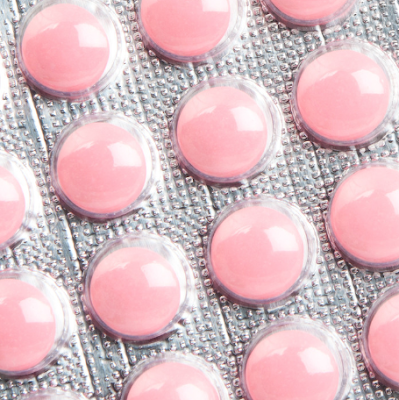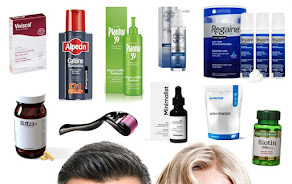How to stop hair loss during menopause
Hair loss doesn't only occur in men, it can also occur in women, too. Hair loss comes in all shapes and sizes, and one of the most common occurrences of hair loss happens in our latter years.
Unfortunately, as we age, our hair becomes thinner, and is prone to falling out. There are two main types of hair loss that occur as we age - androgenic alopecia (male/female pattern baldness) and menopausal hair loss.
In this article, we'll take a look at hair loss during menopause, and list the best medications and non medical treatments available.
What is Menopausal Hair Loss?
Hair loss around the menopause is likely to be caused by changing hormone levels – and your body producing less oestrogen and progesterone. These two hormones keep your hair healthy, making it grow faster and helping it stay on your head longer.
As women age, and go into the menopause, the hair can become thinner, and fall out more regularly. The problem is, the fallen hairs do not get replaced by the new hairs, therefore bald patches can also occur.
How to best treat Menopausal Hair Loss?
There is no cure for any type of hair loss, including menopausal hair loss, but there are some treatments that can help minimise the thinning, and even boost the function of healthy hair growth.
Treatments that are effective are few and far between, so it is important that you find the right ones that work for you, individually. Results tend to vary from person to person, but from a universal standpoint, here, in no particular order, are some of the very best hair loss treatments available for women entering, or going through their menopause...
Topical medication
Minoxidil comes in two main forms - the foam and the liquid - both are equally as effective, but most users prefer to use the foam, as it dries quickly and leaves the hair less greasy than the liquid does. Minoxidil can be purchased as a 5% solution or a 2% solution. The 2% solution is recommended for women, but don't expect miracles, either way.
Minoxidil is generally safe, but the main negative side effects tend to be scalp dryness and irritation, along with headaches, dizziness, and fatigue. Some women have even reported to weight gain and swelling of the ankles, so caution is advised.
Androgen blockers
Androgens are “male” hormones like testosterone, but women have them too. Hair loss in women can occur when “female” hormone levels like estrogen drop off around the time of menopause. That’s where prescription androgen blockers like finasteride might come into play.
Officially, finasteride is approved only for men because it can cause birth defects. But some doctors prescribe it off-label for women with baldness who haven’t benefited from other treatments. It shouldn’t be used by women with a family history of cancer - in fact, it really shouldn't be used by women at all, but some choose to risk it, anyway.
Finasteride comes in both oral and topical formulations. This should be a last resort. Try other, safer treatments first, before committing to finasteride. Again, like minoxidil, finasteride can be effective at stumping hair loss, but you won't see miracles.
Hormone replacement therapy
Most doctors and industry experts would not advise using hormone replacement therapy (HRT) for the sole purpose of treating menopausal hair loss. It is only ever used as a last resort, once option has bee exhausted. There are a few types of HRT. It can be done via taking tablets, using skin patches, oestrogen gels, implants, and through pure testosterone boosting (injections).
This therapy can help boost hair growth, however, it can also come with negative side-effects, with some common ones being; bloating, breast tenderness, headaches, leg cramps, sickness, and swelling.
Low light laser therapy (LLLT)
Low light laser therapy (LLLT) is a massively popular choice of treatment for many women going through various hair loss types. It is a painless treatment, and it does not give any major negative side-effects. It can also be done at a hair clinic, or from the comfort of your own home.
There’s some evidence that LLLT can help improve hair density, thickness and maybe prompt hair regrowth. As with any hair loss treatment, though, results vary from person to person, so do not expect miracles from this or any other treatment.
Platelet-rich plasma therapy (PRP)
Platelet-rich plasma therapy (PRP) is an emerging and semi-experimental treatment that some trichologists and dermatologists are using to treat their patients. PRP is a process whereby the blood drawn from one part of the body, so that the plasma (part that promotes cell growth) can be separated out, and then injected into several areas on the scalp.
There’s some evidence that PRP can be quite effective, and it seems to work best when combined with some of the other treatments mentioned on this list. Be warned, though, because PRP is an expensive treatment. It can cost around £1,000 per session, and you’ll need a series of three before you find out whether it’s working.
Hair transplantation
A hair transplant is a surgical procedure that involves taking hair follicles from one part of your body (the donor area), and reinserting them in the balding areas of the scalp. This is more commonly done by men, but some women have undergone a hair transplant, too.
Hair transplants are the most expensive hair loss treatment type, and results are still not guaranteed. Side effects may include scalp and facial swelling and tenderness. Some people also experience postoperative bleeding and infection.
Keratinocyte growth factor (KGF)
KGF is an important endogenous mediator of hair follicle growth, development, and differentiation. Normalisation of the nu/nu follicular differentiation defect and amelioration of chemotherapy-induced alopecia. KGF is most commonly used as a topical serum.
KGF is generally regarded as a safe option to try, and can be effective in women who are experiencing hair loss during their menopause.
HR23+® Hair Restoration Supplement
Non-medical multivitamin extract supplements can help reduce hair thinning, and boost the function of stronger, faster hair growth. Market leader, HR23+®, caters for the production of tyrosine, which is essential for the development and maintenance of hair follicle cells. This constructs capillaries, which improves the blood flow to the scalp, thus stimulating hair growth.
HR23+® also helps form lecithin to develop and maintain healthy hair cells, as well as increase the effectiveness of inositol, to help protect hair follicle membranes. This hard working supplement targets at the root cause of hair loss, and 9 out of 10 female users noticed visible improvements in their hair.
HR23+® is a safe treatment to use, and is an excellent alternative to harsh medications and surgical procedures. If you are experiencing menopausal hair loss, then HR23+® should be worth considering. This product is a tad pricey (coming in at £49.95 per bottle), but this price can be reduced when you purchase multipacks, or take advantage of their regular offers and discounts.

















Post a Comment